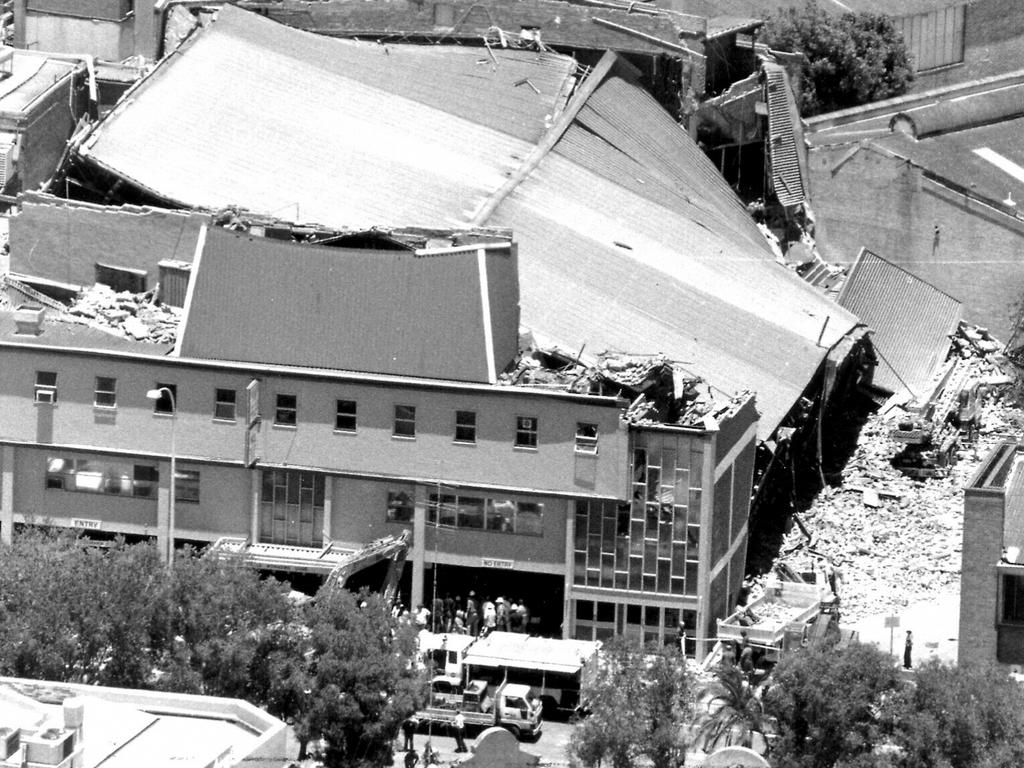Newcastle’s history of quakes did not prepare locals for disaster of 1989
Pokie players at the Newcastle Workers Club suddenly saw their world go dark on December 28, 1989 as the building collapsed during a devastating earthquake
It was morning at the Newcastle Workers Club, on a Thursday just after Christmas in 1989. The sound of the pokies being played was not as loud as it normally would have been, because many club patrons were unable to get there due to a bus strike.
But those forced to stay home were the lucky ones. Because at 10.27am the building began to shake.
Before they could begin to fathom what was happening people at the club saw their world go black.
The roof came crashing down along with the floors below, sending pokies, chairs, and people crashing down toward the basement car park. Nine people were killed and dozens seriously injured as they became trapped beneath the rubble.
Out in the streets of the city there was chaos, people were shocked by the sound of a loud bang, one was taken to hospital suffering from the shock and later died. Roads were cracked, electricity was cut, thousands of buildings damaged, clouds of dust and smoke filled the air.

In an instant the city to Sydney’s north had been transformed into something looking like a war zone. Facades of some buildings dropped away, exposing inner rooms and spilling debris on the footpaths and roads. Along Beaumont St in the suburb of Hamilton walls and awnings had collapsed, killing three people.
Some wondered whether there had been an explosion, but it soon became clear that the damage was widespread and that Newcastle had been hit by an earthquake, registering a magnitude of 5.6. It seemed an inexplicable disaster to many. Earthquakes seemed like things that only happened in places like California and Japan, places where tectonic plates met and where seismic activity was a regular occurrence.
Newcastle seemed to be nowhere near the active edge of a tectonic plate. Some would later try to argue that the disaster had been brought about by coal mining, but the epicentre of the 1989 earthquake was not in a coal mining area. It was also not the first time Newcastle had been rocked.

As far back as the 19th century there had been serious quakes recorded in Newcastle. An account in a newspaper from 1842 describes a tremor that happened in the early hours of the morning of November 28, shaking people from their beds and bringing down the walls of houses.
The story also tells of some “extraordinary atmospheric changes” that preceded the quake, including a thick haze covering the city and a “deathly stillness” followed by “incessant lightning” and rain, although these were most likely entirely unrelated. The paper reports that this was the “fourth shock of earthquake felt on the Hunter since the commencement of the month of August, 1837”. The magnitude of the 1842 quake was estimated at 5.3.
On June 18 in 1868 another serious earth movement took place, estimated to be around magnitude 5.3.

Houses were rocked so violently in some areas that occupants feared they would fall, others reported rattling crockery or drawers being flung open. But nobody was injured and no buildings destroyed.
A 1906 quake ruptured water and gas mains and damaged homes along a section of Terrace St, but was blamed by some on subsidence. Another 5.3 tremor hit
the city in 1925, causing widespread panic, but this time the quake was centred near Sydney.
But despite that history of earthquakes little had been done to prepare Newcastle for future tremors. When the quake hit on December 28, 1989 many buildings quickly crumbled, including the Workers Club, where a report later found that the pillars on one side were not strong enough to support the building and would have been severely stressed had the place been packed with people, much less the powerful stress of a quake.

One woman pulled from the rubble of the club remembered winning $50 on a pokie, but as she went to collect her winnings the lights went out and she ended up falling toward the basement, crying out in the darkness afterwards to be rescued.
Local TV news reporter Ross Hampton was interviewing someone about the bus strike when he felt the tremor, his crew still filming as people ran for cover, thinking a bomb had gone off. He later calmly reported: “This is Hamilton St just minutes after the blast, or the explosion or the earthquake.”
Rescue teams worked for hours freeing people from ruins and searching for others, often hampered by the fragility of the buildings, but using infra-red technology to help with the search. About 50,000 buildings were damaged, hundreds beyond repair had to be knocked down.
The damage was estimated in the billions of dollars.



